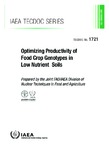Please use this identifier to cite or link to this item:
http://www.alice.cnptia.embrapa.br/alice/handle/doc/979298Full metadata record
| DC Field | Value | Language |
|---|---|---|
| dc.contributor.author | FRANZINI, V. I. | pt_BR |
| dc.contributor.author | MENDES, F. L. | pt_BR |
| dc.contributor.author | MURAOKA, T. | pt_BR |
| dc.contributor.author | TREVISAM, A. R. | pt_BR |
| dc.contributor.author | ADU-GYAMFI, J. J. | pt_BR |
| dc.date.accessioned | 2014-02-10T11:11:11Z | pt_BR |
| dc.date.available | 2014-02-10T11:11:11Z | pt_BR |
| dc.date.created | 2014-02-10 | pt_BR |
| dc.date.issued | 2013 | pt_BR |
| dc.identifier.citation | In: OPTIMIZING productivity of food crop genotypes in low nutrient soils. Vienna: FAO: IAEA, 2013. | pt_BR |
| dc.identifier.uri | http://www.alice.cnptia.embrapa.br/alice/handle/doc/979298 | pt_BR |
| dc.description | Common bean (Phaseolus vulgaris L.) represents the main source of protein for the Brazilian and other Latin-American populations. Unlike soybean, which is very efficient in fixing atmospheric N2 symbiotically, common bean does not dispense with the need for N fertilizer application, as the biologically fixed N (BNF) seems incapable to supplement the total N required by the crop. A experiment under controlled conditions was conducted in Piracicaba, Brazil, to assess N2 fixation of 25 genotypes of common bean (Phaseolus vulgaris L.). BNF was measured by 15N isotope dilution using a non-N2 fixing bean genotype as a reference crop. The common bean genotypes were grown in low (2.2 mg N kg-1 soil) or high N content soil (200 mg N kg-1 soil), through N fertilizer application, as urea-15N (31.20 and 1.4 atom % 15N, respectively). The bean seeds were inoculated with Rhizobium tropici CIAT 899 strain and the plants were harvested at grain maturity stage. The contribution of BNF was on average 75% of total plant N content, and there were differences in N fixing capacity among the bean genotypes. The most efficient genotypes were Horizonte, Roxo 90, Grafite, Aporé and Vereda, when grown in high N soil. None of the genotypes grown in low N soil was efficient in producing grains compared to those grown in high N soil, and therefore the BNF was not able to supply the total N demand of the bean crop. | pt_BR |
| dc.language.iso | eng | eng |
| dc.relation.ispartofseries | (IAEA Tecdoc, 1721). | pt_BR |
| dc.rights | openAccess | eng |
| dc.title | Biological nitrogen fixation efficiency in brazilian common bean genotypes as measured by 15N methodology. | pt_BR |
| dc.type | Parte de livro | pt_BR |
| dc.date.updated | 2017-05-31T11:11:11Z | pt_BR |
| dc.subject.thesagro | Feijão | pt_BR |
| dc.subject.thesagro | Genótipo | pt_BR |
| dc.subject.thesagro | Nitrogênio | pt_BR |
| dc.format.extent2 | p. 299-309. | pt_BR |
| riaa.ainfo.id | 979298 | pt_BR |
| riaa.ainfo.lastupdate | 2017-05-31 | pt_BR |
| dc.contributor.institution | VINICIUS IDE FRANZINI, CPATU; CPATU; CENA/USP; CENA/USP; International Atomic Energy Agency. | pt_BR |
| Appears in Collections: | Capítulo em livro científico (CPATU)  | |










